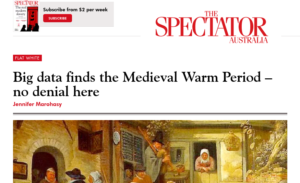Big data finds the Medieval Warm Period – no denial here
By Jennifer Marohasy
Excerpt: Our new technical paper in GeoResJ (vol. 14, pages 36-46) will likely be ignored. Because after applying the latest big data technique to six 2,000 year-long proxy-temperature series we cannot confirm that recent warming is anything but natural – what might have occurred anyway, even if there was no industrial revolution.
Over the last few years, I’ve worked with Dr John Abbot using artificial neural networks (ANN) to forecast monthly rainfall. We now have a bunch of papers in international climate science journals showing these forecasts to be more skilful than output from general circulation models.
During the past year, we’ve extended this work to estimating what global temperatures would have been during the twentieth century in the absence of human-emission of carbon dioxide.
We began by deconstructing the six-proxy series from different geographic regions – series already published in the mainstream climate science literature. One of these, the Northern Hemisphere composite series begins in 50 AD, ends in the year 2000, and is derived from studies of pollen, lake sediments, stalagmites and boreholes.
Typical of most such temperature series, it zigzags up and down while showing two rising trends: the first peaks about 1200 AD and corresponds with a period known as the Medieval Warm Period (MWP), while the second peaks in 1980 and then shows decline. In between, is the Little Ice Age (LIA), which according to the Northern Hemisphere composite bottomed-out in 1650 AD. (Of course, the MWP corresponded with a period of generally good harvests in England – when men dressed in tunics and built grand cathedrals with tall spires. It preceded the LIA when there was famine and the Great Plague of London.)
Ignoring for the moment the MWP and LIA, you might want to simply dismiss this temperature series on the basis it peaks in 1980: it doesn’t continue to rise to the very end of the record: to the year 2000?
In denial of this problem, leading climate scientists have been known to even graft temperature measurements from thermometers onto the proxy record after 1980 to literally ‘hide the decline’. Phil Jones, the head of the Climate Research Unit, University of East Anglia, aptly described the technique as a ‘trick’.
Grafting thermometer data onto the end of the proxy record generally ‘fixes’ the problem after 1980, while remodelling effectively flattens the Medieval Warm Period.
There are, however, multiple lines of evidence indicating it was about a degree warmer across Europe during the MWP – corresponding with the 1200 AD rise in our Northern Hemisphere composite. In fact, there are oodles of published technical papers based on proxy records that provide a relatively warm temperature profile for this period. This was before the Little Ice Age when it was too cold to inhabit Greenland.
The modern inhabitation of Upernavik, in north west Greenland, only began in 1826, which corresponds with the beginning of the industrial age. So, the end of the Little Ice Age corresponds with the beginning of industrialisation. But did industrialisation cause the global warming? Tolstoy’s ‘intelligent man’ would immediately reply: But yes!
In our new paper in GeoResJ, we make the assumption that an artificial neural network – remember our big data/machine learning technique – trained on proxy temperatures up until 1830, would be able to forecast the combined effect of natural climate cycles through the twentieth century.
Using the proxy record from the Northern Hemisphere composite, decomposing this through signal analysis and then using the resulting component sine waves as input into an ANN, John Abbot and I generated forecasts for the period from 1830 to 2000.
Our results show up to 1°C of warming. The average divergence between the proxy temperature record and our ANN projection is just 0.09 degree Celsius. This suggests that even if there had been no industrial revolution and burning of fossil fuels, there would have still been warming through the twentieth century – to at least 1980, and of almost 1°C.
The Intergovernmental Panel on Climate Change, relying on General Circulation Models, and giving us the Paris Accord, also estimates warming of approximately 1°C, but claims this is all our fault (human caused).
For more information, including charts and a link to the full paper read Jennifer Marohasy’s latest blog post.




